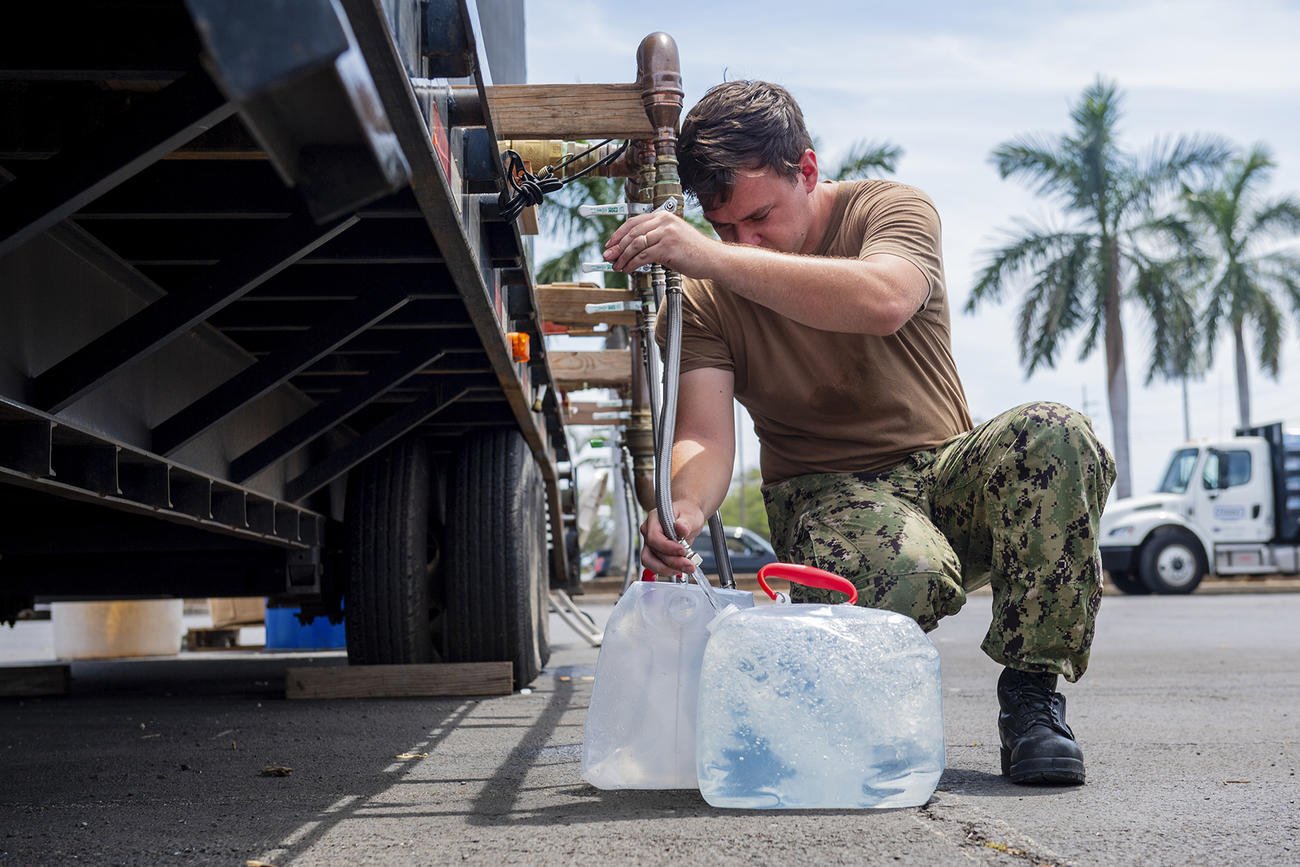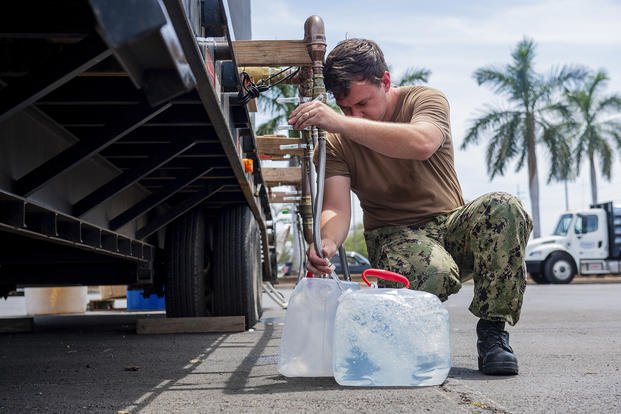

Tests conducted in December by the Hawaii Department of Health found no traces of PFAS, potentially cancer-causing compounds widely known as ‘forever chemicals’ because they don’t break down over time, in the well contaminated by petroleum in a massive spill the month before.
A Navy official said Monday that the health department tested the water for per- and polyfluoroalkyl substances, or PFAS, after investigators found that the fuel that tainted the drinking water at Joint Base Pearl Harbor-Hickam last year had been pooled for months in a fire suppression system line meant to hold firefighting foam containing the chemicals.
But the fire suppression system had never been activated, nor had foam ever been discharged into the system and no PFAS chemicals were detected, a Navy spokesperson told Military.com in an email.
Read Next: Russia Has Suffered Up to 80,000 Military Casualties in Ukraine, Pentagon Says
“A full system activation, e.g., in the event of a fire, would spray [aqueous form filming foam, or AFFF] into the tunnel. This would be a significant event and it has never occurred since the system has been in place,” the spokesperson said.
The question of PFAS contamination of the water has been a concern since the Navy released the results of its investigation into spills that occurred last year at the service’s Red Hill Bulk Fuel Storage Facility, the U.S. military’s largest fuel depot in the Pacific, capable of holding up to 250 million gallons of jet fuel, diesel and gasoline.
PFAS are a collection of nearly 9,000 compounds that have numerous industrial uses but can accumulate in the body and do not break down into soluble components. The Environmental Protection Agency has determined that they are unsafe at any level, and they are associated with infertility, some types of cancer and birth defects.
The investigation revealed that a spill during transfer operations in May sent roughly 19,000 gallons of fuel into the facility’s collection sumps, which were to hold runoff following the activation of its fire system.
When those sumps were accidentally filled with fuel, pumps transferred the liquid into PVC pipes that were designed to retain foam and water runoff. But, the official noted “no AFFF was released on May 6, and therefore no AFFF was pumped from the sump to the reclamation line.”
“The fuel was spilled from an AFFF recovery line, but the AFFF system has never been activated, and therefore the recovery system has never been exposed to PFAS/perfluorooctanoic acid/perfluorooctane sulfonic acid from AFFF,” the spokesman said.
When asked during a congressional hearing July 19 about the possibility of PFAS contamination in the runoff, Vice Adm. Randy Crites, deputy chief of naval operations for capabilities and resources, told Rep. Kaiali’i Kahele, D-Hawaii, that he didn’t know the answer.
In November, the thousands of gallons of fuel from the May spill that were contained in the line were released into the tunnels at the facility after an employee struck one of the pipes with his vehicle.
The contamination sickened military and civilian families living in base housing on or near Joint Base Pearl Harbor-Hickam, sending dozens to hospitals and forcing thousands from their homes for up to three months.
The lack of transparency regarding the May spill and the slow response by the Navy to residents’ complaints in November that their water smelled like petroleum and they were experiencing unexplained symptoms, such as nausea, vomiting, burns and rashes, have left families deeply disaffected. Initially after the November spill, the Navy said tests found the water didn’t contain fuel, despite resident concerns.
Some have moved out of their homes or left the islands altogether, while more than 100 have filed claims against the Navy under the Federal Tort Claims Act seeking compensation for their health problems.
Their attorneys say the families are at risk for long-term conditions such as leukemia, immune disorders, kidney disease, heart conditions, gastrointestinal problems and neurological effects.
“There is enormous fear … They are watching what happened at Camp Lejeune and saying, ‘Is my kid going to die of leukemia; am I going to die of leukemia? How long am I going to be healthy for? Should I start planning for my long-term health now? Those are very real fears,” said Kristina Baehr, an attorney with Just Well Law in Austin, Texas, during an interview July 29 on Military.com’s Fire Watch podcast.
A new research tool unveiled last week by the University of Hawaii has caused further concern among family members who believe that contaminants remain in their drinking water supply.
By using a process called fluorescence spectroscopy, researchers can detect levels of hydrocarbons as low as 10 parts per billion — much lower than the Hawaii Department of Health’s maximum allowable threshold of 211 parts per billion.
As recently as May, this screening detected contamination at the Hickam, Ford Island, and Red Hill Mauka neighborhoods, likely residual contaminants from the November fuel release, according to the researchers.
The researchers cautioned that the screening method, used usually to monitor oil spills, is a preliminary test, and further testing is recommended after any positive findings. They also noted that the method is not certified by the EPA for detecting specific contaminants nor for assessing risk to human health.
But families were swift to react. After Navy Capt. Mark Sohaney posted a letter on the base’s Facebook page Friday reiterating that the water was safe to drink, residents took to the site to express outrage.
Amanda Feindt, whose entire family was sickened by the water in November and her children hospitalized, posted a video of her daughter having a meltdown about drinking any water. The Feindts have left Hawaii but still have health problems, she said.
“Our sweet girl is still traumatized by WATER … she still believes that WATER will make her ‘throw up’ and put her back in the hospital … Unfortunately, this is her reality as she still suffers with many unexplained health issues,” Feindt wrote.
Attorneys representing Red Hill families also implored the Navy to move affected personnel out of military housing.
“Data released by the University of Hawaii Red Hill Task Force this week confirms what our clients already knew to be true: their water is still contaminated,” wrote Baehr and her colleagues at Just Well Law to Navy officials on Thursday. “It’s time to evacuate families affected by the horrific jet fuel spills at the Navy’s Red Hill Bulk Storage Facility in Hawaii.”
Sohaney said the base continues to use only water supplied by a well that was unaffected by the spill.
“JBPHH continuously tests the water you use and provides those water test results to the Hawaii Department of Health and the Environmental Protection Agency who continue to confirm that the JBPHH water remains safe,” Solaney wrote in the letter posted online.
— Patricia Kime can be reached at Patricia.Kime@military.com. Follow her on Twitter @patriciakime.
Related: Military Families File Lawsuit over Water Contamination in Hawaii
© Copyright 2022 Military.com. All rights reserved. This material may not be published, broadcast, rewritten or redistributed.
